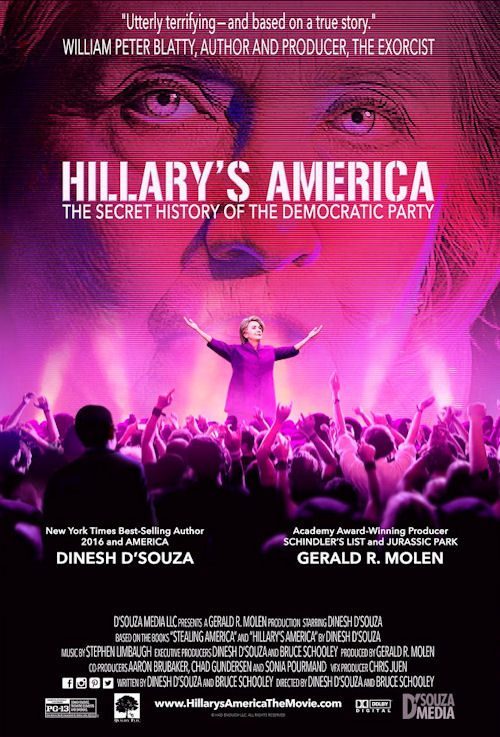DINESH D’SOUZA’S DARK VISION OF “HILLARY’S AMERICA”
Dinesh D’Souza’s Dark Vision of “Hillary’s America”
What Did You Learn In School Today?

What did you learn in school today,
Dear little child of mine?
What did you learn in school today,
Dear little child of mine?
asked folksinger Tom Paxton.
I learned our government must be strong
It’s always right and never wrong!
Our leaders are the finest men
And we elect them again and again,
And that’s what I learned in school today,
That’s what I learned in school.
Tom, this one’s for you, for asking all the right questions, and leaving us to search for the answers. A poet might leave them blowing in the wind, but not this filmmaker.
Mr. Smith Goes to Washington, Grapes of Wrath, 12 Angry Men, certain films come to mind as exemplifying the American character, and the better angels of our nature. Dinesh D’Souza is working the other end of the room, and has created a film to exemplify the worst in our nature, as personified in Democratic nominee Hillary Clinton and what he calls “The Secret History of the Democratic Party,” which is presaged by the opening Happy Days Are Here Again that is dripping with undisguised irony and sarcasm.
Bombay, Indian immigrant Dinesh D’Souza is in better spirits when he celebrates the patriotic songs written by American immigrants. Like them D’Souza clearly wants to pay tribute to his new found country in his films, and ends them all with extended performances of our popular patriotic anthems, as if to say, “I too am America.” One can almost hear Harlem poet Langston Hughes’ subtitle: “The Darker Brother.” But that’s as far as it goes, for D’Souza has a political ax to grind—neo-conservatism—and it finally overwhelms his love of country.
Nearly all of the famous patriotic songs about America are rolled out in a crescendo of climactic paeans to our national greatness at the end of D’Souza’s new destruction myth about one of the two major candidates for president in 2016: Hillary’s America: The Secret History of the Democratic Party. It’s an amazing roll call of American secular hymnody—from God Bless America to America the Beautiful to My Country Tis of Thee to The Star-Spangled Banner—with one small “d” democratic exception—This Land Is Your Land—that reveals the political mindset and obsession of D’Souza’s world view.
What pulls the curtain back on this political Wizard of Oz, however, and reveals him to be a deeply flawed narrator are those he chooses to define the Republican Party throughout his tale of grand larceny in the hands of Democrats. The only Republicans who appear are the well-known good guys—beginning with superstar Abraham Lincoln, down to Ike and Ronald Reagan, all of whom are surrounded with a halo. Who are the equally famous Republican politicians conveniently left out of the story? Richard Nixon, whose dalliance with the Constitution during Watergate threatened the stature and legitimacy of the Republic to which the party gave its name. And Joseph McCarthy, whose rise to power as the Wisconsin senator whose anti-communism was so virulent it led him to make a concerted effort at a one-man coup during the 1954 Army-McCarthy Hearings which culminated in him being censured by the entire US Senate.
Most remarkable of all, however, is the absence of Republican President Herbert Hoover’s America, whose presiding over the Wall Street Crash of 1929 and ushering us into the Great Depression led to the unprecedented four terms of Democrat Franklyn Delano Roosevelt, who gave us the most memorable Inaugural Address line of the 20th Century: “The only thing we have to fear is—fear itself.” I guess that getting us out of the Great Depression, defeating Adolph Hitler and winning World War II was no secret, and so did not rate a mention in D’Souza’s Secret History of the Democratic Party.
In short, there are no Republicans portrayed who are anything less than heroic; and no Democrats who are anything more than disgustingly venal, racist, corrupt, calculating and criminal-minded. Which brings me to the most glaring and yet surprising omission from D’Souza’s galaxy of infamous and absent Republican stars—because for D’Souza it’s 1964 all over again, and yet Senator Barry Goldwater is nowhere to be seen. You could sum up his basic belief system in Goldwater’s notorious campaign slogan—from his 1964 acceptance speech—“Extremism in defense of liberty is no vice, and moderation in pursuit of justice is no virtue.” It is now believed to have sunk his campaign, in raising the alarm of nuclear war. LBJ’s controversial last-minute campaign commercial, in which a young girl is shown picking the petals of a daisy, implied that the very existence of the planet was at stake in this election, given the backdrop of a mushroom shaped cloud. The commercial aired only once, having invited a storm of criticism by suggesting that to vote for Goldwater was to risk nuclear annihilation. But once was enough. Johnson defeated Goldwater in a landslide.
That is the kind of choice facing voters this election, if Dinesh D’Souza’s portrait of Hillary Clinton is to be believed. By the end, to elect her to the White House, who would bring her husband with her as the “First Gentleman,” is seen as tantamount to electing “two depraved criminals.” Phyllis Schlafly’s campaign book for Goldwater, A Choice Not An Echo seems tame by comparison. And yet it also explains why she—at 91 years still the leader in absentia of the conservative movement—was amongst the first to jump on the Trump bandwagon. And yet she is not even mentioned in D’Souza’s film—no doubt because of her staunchly anti-Latino and anti-feminist views and her all-white version of the Republican Party. Why ruin a good story with the facts?
And yet, it is imperative to take D’Souza’s film seriously. It raises important issues whether one agrees with its premise, examples and conclusions or not, and it recalibrates the Democrats’ exaggerated historical narrative, which makes the untold story of Republican compromises with truth and flirtations with fascism all the more alarming. Each major party has balanced the excesses of the other, and D’Souza fails to grasp the genius of the American two-party system that at critical times in our past has protected us from the temptation toward extremism that characterized Europe’s worst excesses of 20th Century horror—from fascism to communism.
That is the film’s fundamental flaw, which comes out at the end, when D’Souza informs his adult school class of immigrants to whom he is teaching English as a Second Language, “How do you know you have become an American?; when you become a Republican.” Now we know how he would have answered Tom Paxton’s question, “What Did You Learn In School Today?” at the beginning of this review. He wants nothing less than to eliminate the Democratic Party altogether. So did Mussolini.
So who are D’Souza’s cast of Democratic villains, who revise the narrative of liberalism and underscore the fact that they do not represent the Democratic Party’s finest hour? Andrew Jackson—he of the $20 bill—Old Hickory, who won the War of 1812’s Battle of New Orleans, with the help of French pirate Jean Laffite, which is never mentioned in the film, again because it would complicate the narrative with something most Americans are proud of. So in place of this Jackson we have the Trail of Tears Jackson, also true, and the slave-owner Jackson who D’Souza shows savagely beating his female slave (which like all of D’Souza’s “historical” scenes is reimagined with actors rather than demonstrated with archival photographs—as a documentary film-maker like Ken Burns would do), and then bedding them—then, with great relish, fast-forwarding to Bill Clinton who is summed up as yet another Democrat who abuses “innocent young woman.” Oy—from beating slaves to Monica Lewinsky, in one head-swiveling moment.
A second much-admired alleged Democratic icon whom D’Souza dismantles was Planned Parenthood founder and original birth control advocate Margaret Sanger. He recreates a scene to great effect of her speaking before a Ku Klux Klan audience, in a concerted effort to show that birth control was only advocated for the purpose of reducing the births of black children—an exercise in eugenics not family planning. I sure didn’t learn that in school. Margaret Sanger did speak before the women’s chapter of the Silverlake, New Jersey Ku Klux Klan in May of 1926. But there was no known photograph of the event. Yet a small detail like that does not deter D’Souza, who uses the doctored photograph that miraculously appeared on Stormfront, a neo-Nazi web site, in which her image is superimposed on that of a burning cross from the original photo. All one has to do is a search of “Margaret Sanger KKK” and the whole escapade is traceable in photo-shopped detail—reinforced by the uncanny neologism “Klanned Parenthood.”
Troubling as that is, however, it pales in comparison to the kicker in the mounting evidence of D’Souza’s “why be confused by the facts?” method of storytelling. For it turns out that Sanger was not in fact a Democrat, but a Republican—after having been a socialist in her early more radical days. Her later party affiliation is documented in Community Digital Media by Joseph Cotto: Margaret Sanger: Humanitarian, Republican, American hero published March 19, 2014. If I could find it, surely Dinesh D’Souza could. And I’m sure he did, he just couldn’t use it, because the truth conflicted with his Republican fairy tale of Democratic Party perfidy.
Just as telling as the less-than-heroic Republicans he leaves out of his film, or who as in this case he misrepresents as a Democrat, are those real Democrats who are real heroes—such as FDR (who is dismissed at the beginning as “not the actual founder of the Democratic Party”) and most amazingly, JFK, President John F. Kennedy. For it was Kennedy who was the architect of what became the Civil Rights Bill of 1964, and whose vision led to our landing a man on the moon (which Goldwater opposed, as he had voted against the Civil Rights Act). And it was Kennedy who created the Peace Corps, which inspired a generation of American students to a life of public service, to fulfill the promise of the second most memorable Inaugural Address line of the 20th Century: “Ask not what your country can do for you; ask what you can do for your country.”
But in Dinesh D’Souza’s world there are no good Democrats and no bad Republicans. Truth—after all—is so much stranger and more nuanced than fiction.
And fiction is what D’Souza’s film Hillary’s America is—until the end, when music saves the day. Suddenly, after the full-frontal assault on Democratic Party history—and a re-casting of the Civil War as not between North and South, but between Republicans and Democrats—D’Souza lets the songs take center stage, in a mounting climax of American patriotic hymns—as described at the beginning. With one exception, which leaves one breathless in its solo voce shimmering beauty; the Negro Spiritual Go Down, Moses, as sung by an unaccompanied contralto. She too is America, the darker sister.
And that, Tom Paxton, is what I learned in school today; that’s what I learned in school.
Ross Altman will perform on Sunday before Labor Day, September 4 at The Church in Ocean Park; 10:15am, 235 Hill St., Santa Monica, CA 90405, his 35th annual appearance to celebrate the music and history of America’s working people. The program is free and open to the public; parking in the Church lot; 310-399-1631.
Saturday October 29 at 2:00pm at the Allendale Branch Library, 1130 S. Marengo Ave. Pasadena, CA 91106 Ross Altman performs his show Ten Songs That Shook the World, originally presented at the Autry Museum of Western Heritage in 1999. 626-744-7260. Free and open to the public.
Los Angeles folksinger Ross Altman, PhD may be reached at greygoosemusic@aol.com.













